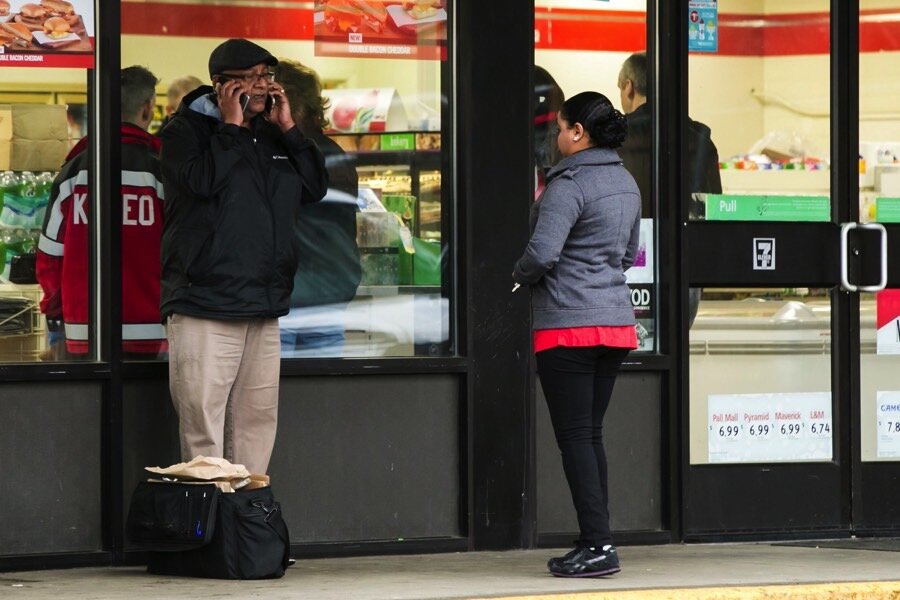Armed citizen stops hatchet attack in Wash. state. How common is that?
Loading...
A regular customer drinking his morning coffee at 7-Eleven fatally shot an attacker armed with a hatchet in Burien, Washington on Sunday, possibly saving the lives of the store clerk and other shoppers.
"Fortunately, because of this customer with his weapon, this could have been a lot worse," King County Sheriff’s Sergeant Cindi West told the local FOX News station.
The sheriff's office was called to the convenience store around 5:45 AM, after a masked man with a hatchet swung the weapon towards a customer, then the clerk, who suffered minor injuries.
A 60-year-old customer with a concealed carry permit fatally shot the attacker, described as a man in his 40s.
"The customer’s a nice guy," one store employee told reporters. "He’s been coming here for about 12 years. He buys scratch tickets, in the morning time. He buys coffee. He’s a good guy."
Since the 1980s, there has been a rapid spread of states allowing citizens to carry concealed firearms. Concealed carry is now permitted in all 50 states, although permitting rules differ. Most require a permit but several do not, including Vermont, West Virginia, Alaska, and Wyoming, and the permit-free movement is poised to spread.
Many gun rights supporters refer to "constitutional carry," reflecting their belief that the Second Amendment, or state amendments, make private handguns a constitutional right. But many others couch their ideas in terms of public safety, arguing that the best way to prevent disasters is have trained, responsible "good guys with guns," that are seen or, as with the 7-Eleven shopper, unseen.
Fifty-six percent of Americans believe the US would be safer if more people carried concealed weapons, after undergoing training and a background check, according to a 2015 Gallup Poll. That's a noticeable difference from 2005, when 65 percent said they would not feel safer in a place with concealed firearms, and only 27 percent said they believed anyone without a criminal record should have concealed carry.
Pro-carry advocates have frequently argued that armed citizens could have prevented some of the country's worst mass shootings, from Sandy Hook Elementary School to the Aurora, Colorado shooting.
"Eliminating or restricting firearms for public self-defense doesn't make our citizens safer; it makes them targets," political commentator and former US secretary of Education William J. Bennett wrote for CNN after the elementary school massacre. "If we're going to have a national debate about guns, it should be acknowledged that guns, in the hands of qualified and trained individuals subject to background checks, prevent crime and improve public safety."
The claim that mass shooters specifically target gun-free locations may be exaggerated. Just 13 percent of the mass shootings between 2009 and 2015 took place in gun-free public places, according to a report by Everytown for Gun Safety, a pro-gun-control group. The same study found that 43 percent of those shooters died during the attack, suggesting that their own safety from other gun-wielders was not a concern.
"The presence of armed security does not seem to be a deterrent," Peter Langman, a psychologist and author of "School Shooters," told Politico. "They’re not trying to get away with it."
But mass shootings, defined as incidents that kill four or more people, represent just a sliver of gun violence in the US. Nailing down statistics to support or refute the "good guy with a gun" safety theory is complicated, analysts say, as is studying whether right to carry (RTC) laws increase or decrease crime in the first place.
In 2003, the National Research Council convened a 16-person committee in hopes of deciding whether RTC had an impact on crime, after researchers John Lott and David B. Mustard argued in the late 1990s that RTC had reduced violent crime. Their findings, however, were inconclusive.
A follow-up study at Stanford, however, included data up to 2010 to try and clarify their findings.
"The totality of the evidence based on educated judgments about the best statistical models suggests that right-to-carry laws are associated with substantially higher rates" of aggravated assault, law professor John J. Donohue III said. Aggravated assault rose by about 8 percent, with smaller increases for rape, robbery, and murder, his team found.
There are several examples of RTC stopping violent crime, however, including two in the past year. In April, an Uber driver with concealed carry permit wounded a man who opened fire on a Chicago crowd, and another permit holder in Philadelphia fatally shot a gunman in a barbershop in March.
But self-defense statistics are hard to come by, particularly since gun permit holders may be defending themselves against a variety of attacks or weapons. The Cato Institute's website provides a national map of incidents in which a gun was used for self-defense.
Many experts remain skeptical about the likelihood of "good guns" saving the day.
"Empirically, there’s good reason to think it wouldn’t have the beneficial effects people think," Robert J. Spitzer, a political science professor at the State University of New York, Cortland, and author of "Guns Across America," says in an interview last week with The Christian Science Monitor. But he calls the imagery "very powerful."
"What if I'd been in that movie theater?"






